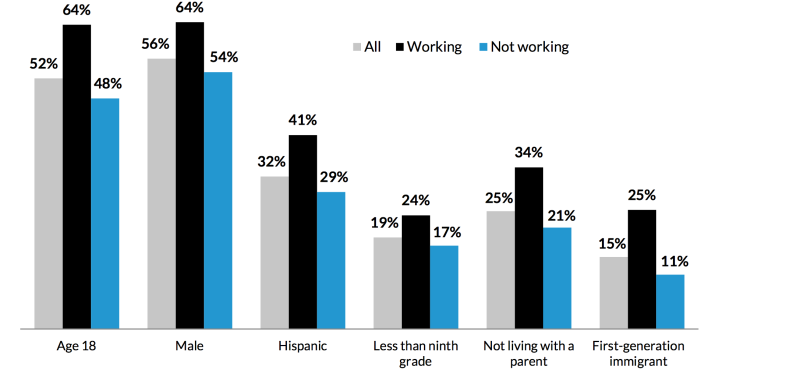 Among high school dropouts in the United States, there is group of teens that would actually prefer to be in a science classroom dissecting a frog or enjoying pizza with their friends after school. Instead, they are parking cars, flipping burgers, or breaking their backs at a construction site.
Among high school dropouts in the United States, there is group of teens that would actually prefer to be in a science classroom dissecting a frog or enjoying pizza with their friends after school. Instead, they are parking cars, flipping burgers, or breaking their backs at a construction site.
Why? They need the money.
Roughly 30 percent of students who drop out of school between the ages of 16 and 18 are working in a variety of jobs, according to a new study by the Urban Institute, a non-profit research group based in Washington, D.C. These young workers are disproportionately Hispanic and first-generation immigrants, though three-quarters are native-born U.S. citizens.
“These are not disconnected youth,” says Molly Scott, co-author of “Dropping Out and Clocking In: A Portrait of Teens Who Leave School Early and Work.” “Many are economically involved in their family’s financial stability.”
Scott says many of these teens may not be frustrated, unstable, or uninterested in school, or guilty of previous academic or behavioral misconduct.
“They may want to be in school,” says Scott, who together with Heather Koball and Simone Zhang compiled the report with data from the U.S. Census Bureau’s American Community Survey. “But their families may need their financial help to make ends meet.”
These workers usually fill low-skilled jobs and earn approximately $9,500 a year. About half work 40 weeks or more a year averaging 31 hours a week.
“This added income makes a big difference to families,” Scott says.
On average, working youth contribute almost 22 percent to the family budget while approximately 10 percent of these teen workers contribute more than half.
In many cases, student earnings are the difference between their families living above or below the federal poverty line. Nearly a third of these families fall below the poverty line while another third are living slightly above that level. As such, student earnings boost 42 percent of poor households over the poverty line. The Department of Health and Human Services sets the poverty line for a family of five at $28,410.
 Characteristics of Youth Ages 16 to 18 without a High School Diploma and Not Enrolled in School, by Employment Status.
Characteristics of Youth Ages 16 to 18 without a High School Diploma and Not Enrolled in School, by Employment Status.
Source: Urban Institute/ American Community Survey 2008–12
“There is so much poverty in so many families,” says Scott. “These students often decide to help provide for their parents, siblings, and themselves.”
Scott is quick to point out the wide range of family circumstances and individual stories involving students who’ve left school to work full time.
“In some cases, kids hand over their paychecks to parents, while others notice a need in their families and decide to pay for utilities, groceries, school supplies, and clothes for themselves and siblings,” Scott says. “There are also cases where youth essentially support themselves within their families or move out on their own.”
In addition to the harsh economic realities of these families, many of the parents, guardians or other household authority figures often lack high school diplomas, with a disproportionately large share not having completed eighth grade.
“Youth living in households with so little education,” Scott says, “are more than twice as likely to drop out and work than other kids who leave school early.”
Another reason students may drop out and work involves their families’ limited access to federal aide: only 17 percent receive social security or temporary assistance (TANF benefits), and only 23 percent receive food stamps.
Scott says there is limited research on the career trajectory of these workers. Do they return to school for a diploma or GED? Decide to attend a community college or university? Enroll online with a higher education institution? Or, continue working and either advance in their careers or bounce between a series of low-wage, dead-end jobs?
“Whatever the case, we must help ensure that youth employment supports ongoing education,” she says. “If a lot of low-income youth are, in fact, dropping out in whole or in part to help meet their basic needs, our approaches to supporting these kids may need to change.”
While the country’s public school system cannot be blamed, new approaches to keeping these students in school must go beyond programs focused on academic enrichment or behavioral intervention, Scott says.
“We need to find solutions that will alleviate material hardships for both parents and teens,” she says. “These kids shouldn’t have to trade their futures to address their family’s short term financial problems.”







